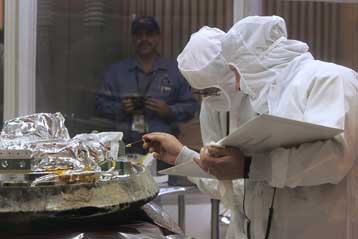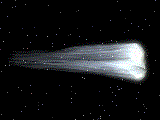Flying Steady: Mission Control Tunes Up Aqua’s Orbit
By Holli Riebeek. Design by Robert Simmon. August 18, 2009
Set into orbit to monitor Earth’s atmosphere and water systems, NASA’s Aqua satellite must maintain a very precise orbit. Gravity pulls at the satellite, gradually changing the angle of its orbit and making it necessary for engineers in mission control to correct the orbit. This article follows events during a recent orbital adjustment maneuver.
April 23, 2009, 15:12:00 UTC: NASA’s Aqua satellite comes around the limb of the Earth into the view of an orbiting Tracking and Data Relay Satellite in position to connect Aqua with its controllers on the ground. The Earth beneath Aqua is dark, except perhaps for moonlight reflecting off clouds over the icy North Pacific Ocean.
In Aqua’s Mission Control Center at NASA Goddard Space Flight Center in Greenbelt, Maryland, it is 11:12 in the morning on a sunny, cool spring day. A group of engineers have gathered in two adjoining control rooms. Each sits at a computer station tracking the satellite’s position and status in dark-colored charts and lines of computer code. Above them, blue neon numbers flash a countdown: 40 minutes until loss of signal. In 40 minutes, the satellite moves out of view of either the data relay satellite or a ground station. In that time, they have to turn the satellite approximately 90 degrees, fire the thrusters to alter its orbit, and then turn the satellite to face forward again, ready to collect data. They’ve been planning this move for more than a year.
15:15:14 UTC: Aqua’s onboard computer detects that the satellite is pointing the wrong direction. It should correct this error by turning 86.466 degrees to the right. It fires its four thrusters to initiate the turn.
The error is a fiction, sent to the computer earlier to get the satellite to turn itself around, or “slew out” in engineer speak. In Mission Control, guidance, navigation, and control engineers Scott Blanchard and John Nidhiry watch the data flowing down from the satellite, tracking to see if the satellite will follow the commands they had previously sent to it. Blanchard lifts a blocky phone (the “SCAMA,” or station conferencing and monitoring arrangement):”Initiating slew out.” His voice carries over the SCAMA to identical devices at each station in the room or anywhere else in the world where team members might be gathered. A few feet away, flight systems manager James Pawloski responds into the intercom system: “Copy, flight.” 36 minutes and 46 seconds are left.
If things go according to plan, the turn should take 9 minutes and 55 seconds. The turn is necessary because the flight team plans to shift Aqua’s orbit closer to the pole by a hundredth of a degree to maintain the strict orbit required for precise science measurements of Earth’s oceans and water cycle.
On the daytime side of the Earth, Aqua orbits from south to north (called an ascending polar orbit), not passing directly over either pole, but coming close to each. Crossing near the North Pole onto the nighttime side of Earth, the satellite moves south again to the South Pole. As the satellite circles, the Earth spins underneath it, so that on each orbit, Aqua is over a different place on Earth. In a single day, the widest-viewing sensor on the satellite will cover most of the Earth’s surface.
Aqua is a scientific research satellite, set into to orbit to provide information about Earth’s water systems—both in the atmosphere and on the surface. Such measurements are crucial in understanding the climate system. If they are to be used to study climate change, the measurements must be consistent over time so that scientists can make valid comparisons. That means that each measurement needs to be taken at about the same time of day to ensure that the angle of the sunlight falling on the ocean, atmosphere, or land and reflecting back to the satellite is as consistent as possible.
To achieve this consistency, Aqua is in a polar orbit that takes it over the equator between 1:30 and 1:45 p.m. local time on every daytime orbit. The satellite crosses the poles at a very precise location, and then circles around the nighttime side of the Earth, moving over the equator between 1:30 and 1:45 a.m. local time. This type of special polar orbit is called a frozen Sun-synchronous orbit.
It takes work to maintain a frozen Sun-synchronous orbit. Tugged by the Sun and Moon, polar-orbiting satellites gradually drift from a north-south orbit to an orbit that leans east-west. Eventually, Aqua’s orbit will shift enough that it no longer follows the afternoon sunlight around the globe. To compensate for gravity’s pull, Aqua’s controllers have to shift the satellite’s orbit toward the pole (right relative to its forward motion at night) every couple of years. Since the thrusters are on the back of the spacecraft, the satellite has to turn to face right so that when the thrusters fire, the satellite moves right.
15:16:00 UTC: Aqua’s instruments begin to notice that Earth is not where it should be and that the satellite’s motion is off. The satellite sends a distress signal to Mission Control.
“Red alarms,” one of the online engineers in contact with the satellite reports over the SCAMA. In the adjoining room, red and yellow grids flash across one of Pawloski’s computer screens. He is expecting the alarms: they mean that the instruments are correctly reporting that the satellite is turning. “Ignore red alarms.” A little more than 35 minutes are left.
If the satellite does not turn quickly enough, Pawloski will abort the maneuver. There has to be time to complete the burn that will shift the orbit and then turn the satellite back around before Aqua crosses into the daytime side of the Earth. Some of Aqua’s instruments are sensitive to solar radiation. They are shielded as long as the satellite faces forward, but when the satellite turns, light and other electromagnetic energy can get into the instruments. Since the shields don’t protect the instruments from the Sun while the satellite is turned during the maneuver, the flight team uses the Earth as a shield, turning the satellite while it is on the dark side of the Earth. The entire maneuver has to be finished and the satellite turned to place the shield between the sensors and the Sun before Aqua comes back around into the light.
At the guidance, navigation, and control station, Blanchard and Nidhiry intensely watch the satellite’s movement. “Halfway through slew,” Blanchard reports with 31 minutes and 52 seconds to go. The turn is on schedule. Conversations begin floating around the room while everyone waits for the satellite to finish its turn










